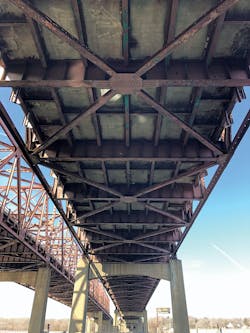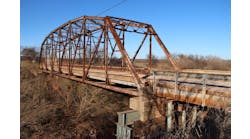By: Bill Wilson
Joliet, Ill., was at one time a true blue-collar city. Steel fabrication echoed through the streets of this river dwelling … a constant buzz was in the air.
Today that collar is badly faded and has a couple of noticeable stains on it, one being the I-80 bridge over the Des Plaines River, specifically its westbound portion which received a bridge inspection report full of engineering expletives a year ago, and still remains open to traffic today with a promise of repair work in May.
Joliet has a total of five bridges crossing the Des Plaines River, and all of them have lost significant strength over the years. The Ruby Street Bridge, which carries S.R. 53, West Bridge Street Bridge, Cass Street Bridge, Jefferson Street Bridge, and the I-80 westbound and eastbound structures are all structurally deficient. Four of them received a rating of 2 out of 9 in at least one bridge inspection category over the last year. The Ruby Street Bridge received a 2 in the Deck Geometry category, with inspectors tagging it “structurally intolerable” and a “high priority for replacement.” The West Street Bridge received identical marks, as did the Jefferson Street Bridge, which also received a 3 rating in the Structural Evaluation category marked “structurally intolerable.” But the most critical span is the I-80 bridge, which is made up of two spans that carry over 84,000 cars every day. The I-80 westbound bridge received a rating of 2 in the Superstructure and Structural Evaluation categories, with the superstructure flagged in critical condition which “may require closure.” The eastbound portion is in only slightly better health, receiving a 3 rating in the Structural Evaluation category.
According to Sarah Wilson, bureau chief for bridge maintenance for the Illinois DOT, District 1, the last full bridge inspection on the I-80 bridge was conducted in April 2018, where IDOT identified some additional locations of section loss and also identified some other areas where the bearings had some issues. After the inspection the I-80 span has been checked every three months.
“We had been working on repair plans to this bridge,” Wilson told Roads & Bridges. “Every three months we will come out and take a look at the areas of concern. Not the entire bridge, but the areas of concern.”
IDOT is planning on spending over $5 million in repairs on the westbound structure, where section loss can be seen on at least 10 sections of the steel truss bridge, which was built in 1965. At press time the agency was sending the job out to bid. Repair work will entail replacing all of the bearings on the approach spans as well as plating any areas of significant loss.
“This did set off a lot of alarm bells in Joliet from the people who travel that bridge, and we have people living underneath it,” Joliet Mayor Bob O’Dekirk told Roads & Bridges. “This is a major bridge over the Des Plaines River, and we do know the road needs serious improvement and the bridge needs serious improvement.”
“[The spring fix] is fine, but what does that do?” John Greuling, president and CEO of the Will County Center for Economic Development, told Roads & Bridges. “Does it take it from a 2 to a 5, or does it take it from a 2 to a 2.5? We are not getting that information [from IDOT].
“We need [IDOT] to be responsive,” Greuling continued. “We need them to be telling us they got things under control, and to date we haven’t heard a lot of that.”
When asked about IDOT’s communication strategy for the I-80 bridge, IDOT spokesman Guy Tridgell said the agency has had “many individual discussions with elected officials, local media, and residents about the bridge and our plans.”
The weather also has been a serious factor this winter. The Chicagoland area experienced one of its coldest days on record on Jan. 30 when the temperature dropped to -23°F and wind chill values more than doubled that number. Bitter cold days have been followed up by mild days where it has reached the low 50s.
Officials believe weather might have played a role in a structural failure on a bridge on Lake Shore Drive in Chicago just 12 days after the polar vortex struck the area. Crews spotted at least two cracked steel beams, and the city closed the bridge for repairs.
“I don’t think there is any one cause for what happened out there but certainly the temperature swing was part of it,” said Wilson, who oversees all state-owned bridges in Cook County, including Chicago. “It puts stress on the bridge to have to expand and contract that much, and if the bearings aren’t free to move, it puts stress on the bridge.”
The I-80 bridge crossing the Des Plaines River in Joliet, Ill., carries over 84,000 vehicles every day. The I-80 westbound structure received a rating of 2 in the Superstructure and Structural Evaluation categories, with the superstructure flagged in critical condition. The eastbound portion is in “better” health, receiving a 3 rating in the Structural Evaluation category.
Advertising it to everybody
Putting stress on IDOT are a number of community groups, including the I-80 Coalition, which Greuling helped form, and Local 150, which bought ad space on an electronic billboard near the I-80 bridge warning drivers they were about to cross a dangerous bridge.
“It looks like an actual warning,” said Greuling. “If you are Joe Sunday driving his family east to west through Joliet and see that, maybe you are thinking you should turn around. It certainly makes my life miserable trying to recruit business here.”
However, when language like “structurally intolerable” is leaked to the public, often it stirs the wrong reaction. IDOT insists that despite the critical condition of the I-80 bridge, the span is ultimately safe to cross.
“The in-depth, detailed inspection performed by IDOT last year identified less than a dozen such locations out of more than 1,000 on the bridge that warranted the rating,” Tridgell said in an email. “Our experienced staff determined that, with a special three-month follow-up inspection that reviewed those particular locations, combined with a plan for repairs in 2019, the bridge could safely remain in place.”
Revamping the I-80 corridor, or parts of it, in Illinois has been talked about for years. Greuling said as far as the I-80 bridge goes, the focus was on safety, not structural integrity. Poor merging areas and the amount of truck traffic makes traveling over the span an everyday hazard. IDOT is proposing a $1 billion I-80 fix, which covers a stretch in Will County and includes a total replacement of the I-80 bridge, and will contain enough money to rebuild interchanges, bridges, replace some pavement, and in some cases add capacity in the form of acceleration and deceleration lanes. A much bigger proposal that would extend the project further east to I-294 near the Indiana border also has been floated, but would require buy-in from the Illinois Tollway or a public-private partnership.
Funding for road and bridge improvements continues to be at a low point in the state of Illinois. There has not been a major capital bill in a decade, and the gas tax has not been increased in more than a decade. Legislators introduced a bill that would fund a pilot project for a mileage-based charging system, but it never got off the ground in Springfield. At press time the Illinois Senate added an amendment to Senate Bill 103 that would double the state gas tax to 38 cents a gallon.
“If the governor came to me today and said we can’t give you the billion right now, but I could come up with $300 million—where do you want to spend it, I would say do the [I-80] bridges and the interchanges on each end. If we are going to do it in pieces that has to be the next piece,” noted Greuling.
About The Author: Wilson is editorial director of Roads & Bridges.




